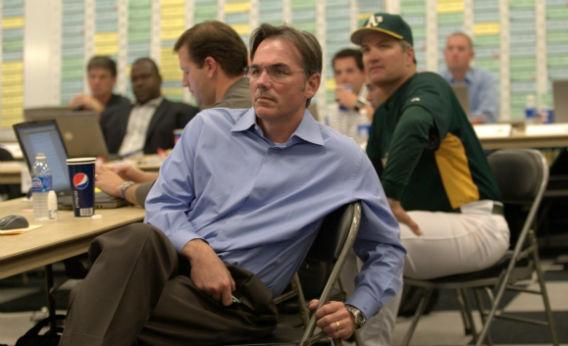Michael Lewis is a prolific nonfiction writer, author of The Big Short, Liar’s Poker, Moneyball, The Blind Side, as well as hundreds of articles for The New Republic, Vanity Fair, and The New York Times.
The Trading Desk, which appeared in the March 30, 2003 edition of the New York Times Magazine, was adapted from his book Moneyball, which would later be made into a movie starring Brad Pitt. But even if you never read the book or saw the film, this 8900-word feature article would stand on its own. It’s a great story about the changing business of baseball, Oakland A’s general manager Billy Beane, and the players who get moved around like playing pieces on a board.

Photograph by Michael Zagaris/Getty Images
At the heart of the story is the way Beane defied conventional wisdom about how to evaluate baseball players and build teams. With limited money to spend and fewer star players to use as assets for trades, Lewis shows Beane to be gutsy and resourceful, relying on mathematics, data, and personal charm to do what he can’t with a large payroll.
Here, he frames the larger context for all the action in the story:
For more than a decade, the people who run professional baseball have argued that the game was ceasing to be an athletic competition and becoming a financial one. The gap between rich and poor teams in baseball is far greater than in football and basketball, and widening rapidly. In the middle of the 2002 season, the richest team, the New York Yankees, had a payroll of $133.4 million, while two of the poorest teams, the Oakland A’s and the Tampa Bay Devil Rays, had payrolls of less than a third of that. A decade before, the highest-payroll team, the New York Mets, spent about $44 million on players, and the lowest-payroll team, the Cleveland Indians, a bit more than $8 million. The growing raw disparities meant that only the rich teams could afford the best players. A poor team could afford only the maimed and the inept, and was almost certain to fail. Or so argued the people who ran baseball.
But when you actually look at what happened over the past few years, you have to wonder. The bottom of each division has been littered with teams — the Rangers, the Orioles, the Dodgers, the Mets — that have spent huge sums and failed spectacularly. On the other end of the spectrum is Oakland. For the past four years, working with one of the lowest payrolls in the game, the Oakland A’s have won as many regular-season games as any other team except the Atlanta Braves. They’ve been to the playoffs three years in a row and twice taken the richest team in baseball, the Yankees, to within a few outs of elimination. How on earth did they do it? As early as 2000, Commissioner Bud Selig took to calling the Oakland A’s’ success “an aberration,” but that was less an explanation than an excuse not to grapple with the questions: how did they do it? What was their secret?
The story goes about the business of answering that question, using the example of one trade to reveal the thinking and strategy behind Beane’s maneuvers.
Lewis paints the big picture well, but he also zooms in to let us see Beane in action, wheeling and dealing:
He has two hours to find someone who will take Venafro off his hands. The Mets are a good idea. Beane picks up the phone and dials the number for Steve Phillips, the general manager of the Mets. A secretary answers.
“Denise,” Beane says, “Billy Beane, vice president and general manager of the Oakland Athletics. Denise, who is the best-looking G.M. in the game?” Pause. “Exactly right, Denise. Is Steve there?”
Steve isn’t there, but someone named Jimmy is. “Jimmy,” Beane says. “Hey, how you doin’? Got a question for you. You guys looking for a left-handed reliever?”
He raises his fist again. Yes! He tells Jimmy about Venafro. “I can make it real quick for you,” he says.
How quick?
“Fifteen minutes?”
Fine.
“I can give you names in 15 minutes,” Beane says. “Yeah, look, I’d do this if I were you. And I’m not [expletive] you here Jimmy. I’m being honest with you.”
Lewis’ work is great because he does two things very well: he’s a fine explainer, and he writes great scenes. He helps make sense of complex worlds of finance, professional sports, and business, but he doesn’t get buried jargon and acronyms. He doesn’t forget that ultimately, these stories are about people, and takes the time to give the reader a sense of who they are. He delivers a story about a big picture, but pays attention to the details of the people inside the frame.
Read The Trading Desk →